របៀបវារៈឆ្នាំ២០៣០ ត្រូវបានបង្កើតឡើងដើម្បីឆ្លុះបញ្ចាំងថា “សហគមន៍អន្តរជាតិ បានធ្វើការបោះជំហានយ៉ាងសំខាន់ ក្នុងការលើកកម្ពស់មនុស្សចេញពីភាពក្រីក្រ (…)។ ទោះជាយ៉ាងណាក៏ដោយ វិសមភាពនៅតែមាន ហើយវាមានភាពខុសគ្នាយ៉ាងខ្លាំងក្នុងការទទួលបាន សេវាសុខភាព សេវាអប់រំ និងទ្រព្យសម្បត្តិផ្សេងទៀត “។ 1
ទោះបីជា ចំនួនប្រជាជនដែលរស់នៅក្នុងកម្រិតជីវភាព តិចជាង ១,២៥ ដុល្លារក្នុងមួយថ្ងៃ បានធ្លាក់ចុះជាងពាក់កណ្តាល ពី ១,៨ ពាន់លាននាក់នៅឆ្នាំ១៩៩៩ ដល់ ៨៣៦ លាននាក់នៅឆ្នាំ២០១៥ ក៏ដោយ ក៏វិសមភាពដ៏ច្រើន ត្រូវបានរាយការណ៍នៅក្នុងប្រទេសអភិវឌ្ឍន៍ និងប្រទេសកំពុងអភិវឌ្ឍន៍ ក៏ដូចជារវាងប្រទេស។2 វិសមភាពត្រូវបានចាក់ឫសក្នុងកត្តាជាច្រើន ដូចជា ការរិចរិលនៃបរិស្ថាន ភាពក្រីក្រ ភាពគ្មានការងារធ្វើជាប់លាប់ ជម្លោះ អំពើហឹង្សា និងអស្ថិរភាពនយោបាយ។ ហើយវាក៏មានក្នុងទិដ្ឋភាពរចនាសម្ព័ន្ធផ្សេងទៀត ដូចជា ការតំណាងតិចតួច ការរើសអើង កង្វះប្រាក់ឈ្នួលសមរម្យ គោលនយោបាយសង្គម និងសារពើពន្ធជាដើម។
ដូច្នេះហើយ គោលដៅអភិវឌ្ឍប្រកបដោយចីរភាពទី១០ ជួយដោះស្រាយ វិសមភាពលើទស្សនវិស័យទូលំទូលាយមួយ ដើម្បីកាត់បន្ថយភាពខុសគ្នានៅក្នុងប្រទេស និងរវាងប្រទេសនានា។ ចំណុចដៅចំនួន ១០ និងសូចនាករចំនួន ១១ របស់គោលដៅនេះ ពិចារណាអំពី កត្តាសង្គម ស្ថាប័ន និងសេដ្ឋកិច្ច ដើម្បីធានាកំណើនសេដ្ឋកិច្ច ដែលប្រកបដោយបរិយាបន្ន ក៏ដូចជា តំណាង និងឱកាសស្មើៗគ្នា។3
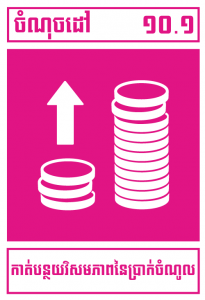 |  | 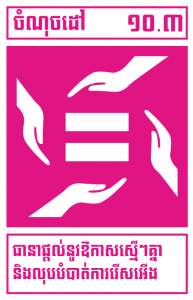 | 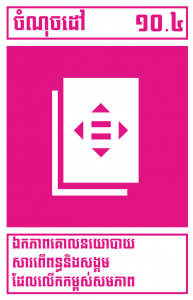 | 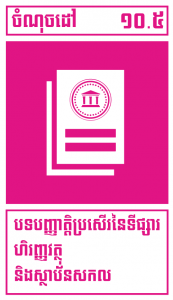 |
 | 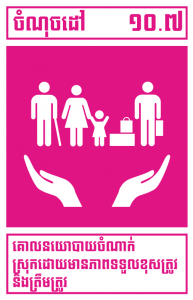 | 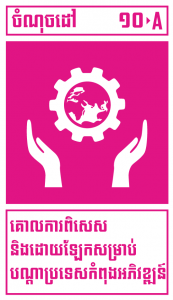 |  | 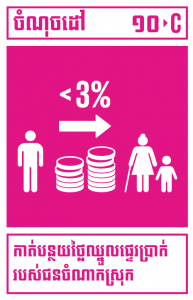 |
ការផ្លាស់ប្តូរពីគោលដៅអភិវឌ្ឍន៍សហស្សវត្សរ៍ ទៅជាគោលដៅអភិវឌ្ឍប្រកបដោយចីរភាព
ដោយមានការកើនឡើងនៃមតិឯកច្ឆន្ទលើគំនិតដែលថា វិសមភាព ជាកត្តារាំងស្ទះដល់ការអភិវឌ្ឍន៍ប្រកបដោយចីរភាព អវត្តមាននៃគោលដៅមួយដើម្បីដោះស្រាយវិសមភាពបែបនេះហើយ គឺជាការរិះគន់ដ៏ខ្លាំងមួយ ចំពោះគោលដៅអភិវឌ្ឍន៍សហសវត្សរ៍ (MDGs)។ កង្វះខាតមួយចំនួនដែលបានកំណត់នៅក្នុងការវាយតម្លៃចុងបញ្ចប់នៃគោលដៅអភិវឌ្ឍន៍សហស្សវត្សរ៍ បានគូសបញ្ជាក់អំពី ការបន្តវត្តមាននៃវិសមភាព និងការចែកចាយផលប្រយោជន៍មិនស្មើគ្នា ដែលបានមកពីកំណើនសេដ្ឋកិច្ច។4
- ដំណើរស្វិតស្វាញនៃវិសមភាពយេនឌ័រ ដោយស្ត្រីប្រឈមនឹងការរើសអើងក្នុងការទទួលបានការងារ ទ្រព្យសម្បត្តិ សេដ្ឋកិច្ច និងការចូលរួមក្នុងការសម្រេចចិត្តជាឯកជន និងសាធារណៈ។ ស្ត្រីទំនងជារស់នៅក្នុងភាពក្រីក្រច្រើនជាងបុរស ហើយនៅតែជួបប្រទះជាមួយគុណវិបត្តិនៅក្នុងទីផ្សារការងារ។
- គម្លាតរវាងគ្រួសារក្រីក្របំផុត និងមានទ្រព្យសម្បត្តិបំផុត។ នៅតាមបណ្តាប្រទេសកំពុងអភិវឌ្ឈន៍ កុមារដែលមកពីគ្រួសារដែលមានជីវភាពក្រីក្រទំនងជាមិនបានចូលសាលារៀន ទទួលរងនូវកង្វះអាហារូបត្ថម្ភ នឹងប្រឈមមុខយ៉ាងខ្ពស់នឹងអត្រាមរណភាពកុមារក្រោមអាយុ ៥ ឆ្នាំ។
- គម្លាតរវាងទីជនបទ និងទីក្រុង។ ប្រហែលជា ៥០ ភាគរយ នៃប្រជាជននៅតាមតំបន់ជនបទ ខ្វះខាតបង្គន់អនាម័យ បើប្រៀបធៀបទៅនឹង ១៨ ភាគរយ នៅតំបន់ទីក្រុង។ ចំនួនកំណើតដែលបានសម្រាលដោយអ្នកអនុវត្តន៍ជំនាញសុខភាពគឺ ៥៦ ភាគរយ សម្រាប់តំបន់ជនបទ និង ៨៧ ភាគរយ នៅទីប្រជុំជន។
- ប្រជាជនក្រីក្រ គឺជាអ្នកដែលទទួលរងផលប៉ះពាល់ខ្លាំងពីបំរែបំរួលអាកាសធាតុ និងការរិចរិលនៃបរិស្ថាន។
- គោលដៅអភិវឌ្ឍន៍សហស្សវត្សរ៍បាននាំមកនូវភាពប្រសើរឡើងច្រើន ប៉ុន្តែការចែកចាយមិនស្មើគ្នានៃកំណើនសេដ្ឋកិច្ច និងការអភិវឌ្ឍ ក៏នាំឱ្យមានដំណើរស្វិតស្វាញ និងការរីករាលដាលនៃវិសមភាពនៅទូទាំងពិភពលោក។
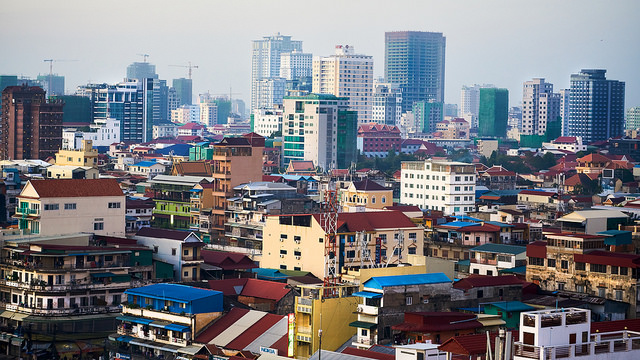
រូបភាពទីក្រុងភ្នំពេញ។ រូបភាព ថតដោយ Bryon Lippincott នៅថ្ងៃទី០៧ ខែមករា ឆ្នាំ២០១៨។ អាជ្ញាប័ណ្ណ CC BY-ND 2.0
ដូចនៅក្នុងករណីនៃគោលដៅអភិវឌ្ឍន៍សហស្សវត្សរ៍ពិភពលោក បញ្ហាវិសមភាពត្រូវបានលើកឡើង នៅក្នុងគោលដៅអភិវឌ្ឍន៍សហស្សវត្សរ៍កម្ពុជា (CMDGs) មួយចំនួនតែប៉ុណ្ណោះ។ គោលដៅអភិវឌ្ឍន៍សហស្សវត្សរ៍កម្ពុជាទី១ រួមបញ្ចូលទាំងសូចនាករ (១C) ដែលព្យាយាម «បង្កើនប្រាក់ចំណូលដែលទទួលបានពីអ្នកក្រីក្របំផុតចំនួន ២០ ភាគរយ ទៅ ១២ ភាគរយនៃប្រាក់ចំណូលសរុប»។ គោលដៅអភិវឌ្ឍន៍សហស្សវត្សរ៍កម្ពុជាទី២ (២D) បានលើកឡើងពីវិសមភាពក្នុងវិស័យអប់រំ និងបានស្វែងរកសមភាពយេនឌ័រនៅកម្រិតបឋមសិក្សា។ គោលដៅអភិវឌ្ឍន៍សហស្សវត្សរ៍កម្ពុជាទី៣ (៣A, ៣B និង ៣C) បានផ្តោតលើវិសមភាពរវាងយេនឌ័រក្នុងវិស័យសង្គម នយោបាយ និងសេដ្ឋកិច្ច ហើយមានគោលបំណងដើម្បីសម្រេចបាននូវសមភាពយេនឌ័រ ក្នុងវិស័យអប់រំ និងអក្ខរកម្ម ការងារប្រាក់បៀវត្សរ៍ និងដំណើរការធ្វើសេចក្តីសម្រេចចិត្ត។ ការវាយតម្លៃលទ្ធផលចុងក្រោយនៃចំណុចដៅទាំងនេះមានដូចខាងក្រោម៖ ១C មិនទាន់បានបញ្ចប់នៅឡើយទេ, ២D សម្រេចបាន , ៤A សម្រេចបាន, ៣B មិនទាន់បានបញ្ចប់, ៣C មិនទាន់បានបញ្ចប់។
លើសពីនេះទៅទៀត គោលដៅអភិវឌ្ឍន៍សហស្សវត្សរ៍ទី៨ ផ្តោតលើ “អភិវឌ្ឍភាពជាដៃគូសកលសម្រាប់ការអភិវឌ្ឍ» ដោយសង្កត់ធ្ងន់លើតួនាទី ដែលជំនួយអភិវឌ្ឍន៍ផ្លូវការ (ODA) ដើរតួក្នុងការកាត់បន្ថយវិសមភាពរវាងប្រទេសនានា ប៉ុន្តែកម្ពុជាមិនបានកំណត់គោលដៅណាមួយទេទៅលើរឿងនេះ។5
រាជរដ្ឋាភិបាលកម្ពុជាយល់ដឹងយ៉ាងច្បាស់អំពីវិសមភាពក្នុងតំបន់នៅតែបន្តនៅក្នុងប្រទេស ដែលទាក់ទងទៅនឹងប្រាក់ចំណូលនៃ វិស័យសុខភាព ការអប់រំ និងយេនឌ័រ។ ភាពខុសគ្នាខ្លាំងនៅក្នុងស្តង់ដារជីវភាព និងឱកាសការងារ កំពុងធ្វើឱ្យមានភាពខុសគ្នារវាងក្រុមផ្សេងៗរបស់សង្គម និងពង្រីកការបែកចែករវាងជនបទ និងទីក្រុងកាន់តែខ្លាំង។ ការពិតទៅ នេះគឺជាបញ្ហាប្រឈមដ៏សំខាន់មួយសម្រាប់ការអនុវត្តរបស់គោលដៅអភិវឌ្ឍន៍សហស្សវត្សរ៍កម្ពុជា។6
ដូច្នេះ សហគមន៍អន្តរជាតិ បានអំពាវនាវឱ្យមានសកម្មភាពរួមគ្នា ដើម្បីជំរុញឱ្យមានការចែកចាយកាន់តែច្រើន និងផលប្រយោជន៍នៃកំណើន។ របៀបវារៈឆ្នាំ២០៣០ នាំវិសមភាពនៅក្នុងជួរមុខនៃយុទ្ធសាស្ត្រអភិវឌ្ឍន៍ពិភពលោក ដោយសង្កត់ធ្ងន់ថា វិសមភាព គឺជាបញ្ហាសកល និងបញ្ហាអន្តរវិស័យ ហើយនិងរួមបញ្ចូលនូវវិធានការលម្អិត ដើម្បីកាត់បន្ថយភាពខុសគ្នានៃការរីកចំរើនផ្នែកសេដ្ឋកិច្ច របស់គោលដៅអភិវឌ្ឍន៍សហស្សវត្សរ៍កម្ពុជា។7
វិធានការមួយទៀតដើម្បីកាត់បន្ថយវិសមភាពនៅថ្នាក់ជាតិ គឺធានាថាកំណើនប្រាក់ចំណូល ក្នុងចំណោមប្រជាជនក្រីក្របំផុតចំនួន ៤០ ភាគរយ នៃប្រជាជននៅក្នុងប្រទេសនីមួយៗ គឺលឿនជាងមធ្យមភាគជាតិ។ ដើម្បីដោះស្រាយភាពខុសគ្នា ដែលកំពុងកើនឡើងរវាងប្រទេសនានា វានឹងមានការកើនឡើងនៃប្រព័ន្ធអនុគ្រោះពន្ធសម្រាប់ប្រទេសកំពុងអភិវឌ្ឍន៍ និងបណ្តាប្រទេសអភិវឌ្ឍន៍តិចតួច (LDCs) ដើម្បីបង្កើនការនាំចេញ នឹង បង្កើនតុល្យភាពពាណិជ្ជកម្មរបស់ពួកគេ។ ទោះបីជាមានការកើនឡើងនូវការអនុគ្រោះពន្ធ នៅចន្លោះឆ្នាំ ២០០០ និង ២០១៤ ដែលមានតួលេខចំនួន ៧៩ ភាគរយ នៃការនាំចេញសម្រាប់ប្រទេសកំពុងអភិវឌ្ឍន៍ និង ៨៤ ភាគរយ សម្រាប់ប្រទេសអភិវឌ្ឍន៍តិចតួច អត្ថប្រយោជន៍ប្រៀបធៀបនៃប្រទេសទាំងនេះត្រូវការការកែលម្អបន្ថែមទៀត។ គោលដៅនេះ លើកទឹកចិត្តដល់ជំនួយអភិវឌ្ឍន៍ផ្លូវការ និងលំហូរហិរញ្ញវត្ថុដល់រដ្ឋនានា ដែលមានតំរូវការមានភាពធំធេង។ លើសពីនេះទៅទៀតដោយសារទំហំនៃចលនាអន្តោប្រវេសន៍ ជាពិសេសនៅក្នុងបណ្តាប្រទេសកំពុងអភិវឌ្ឍន៍ គោលដៅនេះបានអំពាវនាវឱ្យមានការកាត់បន្ថយតិចជាង ៣ ភាគរយ នៃតម្លៃប្រតិបត្តិការទៅលើការផ្ទេរប្រាក់បញ្ញើរបស់ជនអន្តោប្រវេសន៍។8
ការធ្វើមូលដ្ឋានីយកម្មគោលដៅទី១០ នៅក្នុងប្រទេសកម្ពុជា
ប្រទេសកម្ពុជា គឺជាប្រទេសមួយក្នុងចំណោមបណ្តាប្រទេសកំពុងរីកចម្រើនលឿនបំផុតនៅលើពិភពលោក ដែលមានអត្រាកំណើនប្រចាំឆ្នាំជាមធ្យមប្រកបដោយនិរន្តរភាព ចន្លោះពី ៧ ទៅ ៨ ភាគរយ ។ ទោះជាយ៉ាងណាក៏ដោយ ការរីករាលដាលនៃវិសមភាព ទាមទារឱ្យមានកំណើនបរិយាបន្នច្រើនជាងមុន ដូចដែលត្រូវបានគូសបញ្ជាក់នៅក្នុងក្របខ័ណ្ឌជាតិរួមទាំង ផែនការយុទ្ធសាស្ត្រអភិវឌ្ឍន៍ជាតិឆ្នាំ ២០១៤-២០១៨ និង យុទ្ធសាស្ត្រចតុកោណ។
ដំណើរការដើម្បីសម្របខ្លួនទៅនឹងក្របខ័ណ្ឌសកល ដែលសមស្របទៅនឹងបរិបទរបស់ប្រទេសកម្ពុជា ចាប់ផ្តើមនៅចុងឆ្នាំ២០១៥ មិនយូរប៉ុន្មានបន្ទាប់ពីគោលដៅសកលត្រូវបានអនុម័តនៅឯមហាសន្និបាតរបស់អង្គការសហប្រជាជាតិ។ ទោះបីជាមានការអនុម័តនូវគោលដៅសកលរួមជាមួយអង្គការសហប្រជាជាតិនៅខែកញ្ញា ឆ្នាំ២០១៥ ក៏ដោយ កម្ពុជាមិនបានអនុម័តលើការធ្វើមូលដ្ឋានីយកម្មគោលដៅអភិវឌ្ឍប្រកបដោយចីរភាពកម្ពុជា (CSDGs) រហូតដល់ខែវិច្ឆិកា ឆ្នាំ២០១៨។
ការធ្វើមូលដ្ឋានីយកម្មនៃគោលដៅអភិវឌ្ឍប្រកបដោយចីរភាពកម្ពុជាទី១០ គឺស្របពេលជាមួយនឹងគោលដៅអភិវឌ្ឍប្រកបដោយចីរភាពកម្ពុជាដទៃទៀត ដែលបានអនុវត្តតាមរយៈដំណើរការចូលរួម និងការពិគ្រោះយោបល់ដែលដឹកនាំដោយ ក្រសួងផែនការ (MoP) រួមសហការរវាងភ្នាក់ងារអង្គការសហប្រជាជាតិ ក្រសួងពាក់ព័ន្ធ និងក្រុមការងារបច្ចេកទេសក្រសួង (TWGs) និង អង្គការសង្គមស៊ីវិលមួយចំនួន (CSOs)។ ការវិភាគយ៉ាងម៉ត់ចត់ គឺមានសារៈសំខាន់ក្នុងដំណើរការនៃការរៀបចំ ដូចជាការវាយតម្លៃរួមបញ្ចូលគ្នារហ័ស ដែលបានផ្គូផ្គង គោលដៅអភិវឌ្ឍប្រកបដោយចីរភាពកម្ពុជា និងអាទិភាពថ្នាក់ជាតិ និងការវាយតម្លៃសូចនាករ និងប្រភពទិន្នន័យរបស់ នាយកដ្ឋានស្ថិតិនៃអង្គការសហប្រជាជាតិ (UNSD)។
ការត្រួតពិនិត្យពាក់កណ្តាលឆមាសនៃ ផែនការយុទ្ធសាស្ត្រអភិវឌ្ឍន៍ជាតិ ឆ្នាំ ២០១៤-២០១៨ បានវាយតម្លៃលើកម្រិតត្រួតស៊ីរវាង គោលដៅអភិវឌ្ឍប្រកបដោយចីរភាពកម្ពុជា និងក្របខ័ណ្ឌជាតិ។ ការពិនិត្យឡើងវិញនេះបានលើកឡើងថា គោលដៅអភិវឌ្ឍប្រកបដោយចីរភាពកម្ពុជាទី១០ គឺ៖
- ការបំពេញដោយផ្ទាល់ទៅនឹងអាទិភាពតែមួយគត់ ដែលជាការកាត់បន្ថយភាពក្រីក្រ និងកំណើនបរិយាបន្ន។
- ការបំពេញដោយផ្នែកដើម្បីពង្រីកវិស័យកសិកម្ម ការគ្រប់គ្រងការធ្វើចំណាកស្រុក និងនគរូបនីយកម្ម អភិបាលកិច្ចល្អ និង កែលម្អមូលដ្ឋានធនធានមនុស្ស។
ដោយមាននូវវិធីសាស្ត្រដ៏ទូលំទូលាយ និងមហិច្ឆតានៃរបៀបវារៈរបស់អង្គការសហប្រជាជាតិ ហើយជាលទ្ធផលនៃ គោលដៅអភិវឌ្ឍប្រកបដោយចីរភាពកម្ពុជា រាជរដ្ឋាភិបាលកម្ពុជាបានសង្កត់ធ្ងន់លើតម្រូវការក្នុងការកំណត់អាទិភាព និងកំណត់ដំណាក់កាលនៃការចេញគោលដៅនានា។ រាជរដ្ឋាភិបាលកម្ពុជា តាមរយៈដំណើរការរៀបចំផែនការជាតិ និងរចនាសម្ព័ន្ធនៃការពិគ្រោះយោបល់ នឹងស្វែងយល់ពីគោលដៅសំខាន់ៗ និងបញ្ជាក់បន្ថែមទៀតនូវលំដាប់ដែលពួកគេគួរតែត្រូវដោះស្រាយដោយគោលការណ៍ «មិនបោះបង់នរណាម្នាក់ឱ្យនៅឯកោ»។9
ក្នុងចំណោមចំណុចដៅទាំង ១០ របស់គោលដៅអភិវឌ្ឍប្រកបដោយចីរភាពសកលទី១០ មានតែចំណុចដៅ ៥ តែប៉ុណ្ណោះដែលត្រូវបានកំណត់ថា ពាក់ព័ន្ធនឹងបរិបទកម្ពុជា ហើយត្រូវបានដាក់បញ្ចូលទៅក្នុងគោលដៅអភិវឌ្ឍប្រកបដោយចីរភាពកម្ពុជាទី១០។ គោលដៅទាំងនេះត្រូវតាមដានដោយសូចនាករនីមួយៗ ដោយរាប់បញ្ចូលនូវសូចនាករទាំង ៥ សម្រាប់ គោលដៅអភិវឌ្ឍប្រកបដោយចីរភាពនានា។
មធ្យោបាយនៃការអនុវត្តគោលដៅអភិវឌ្ឍប្រកបដោយចីរភាពទី១០ នៅក្នុងប្រទេសកម្ពុជា
គោលដៅអភិវឌ្ឍប្រកបដោយចីរភាពកម្ពុជា ទាមទារការព្យាករណ៍យ៉ាងល្អអំពីហិរញ្ញវត្ថុ និងធនធានផ្សេងទៀត។ យោងតាមការប៉ាន់ស្មានពីការវាយតម្លៃហិរញ្ញវត្ថុអភិវឌ្ឍន៍ (DFA) ដោយក្រុមប្រឹក្សាអភិវឌ្ឍន៍កម្ពុជា (CDC) នៅឆ្នាំ២០១៧ ទោះបីជា មានការអភិវឌ្ឍន៍ផ្នែកសារពើពន្ធ និងសេដ្ឋកិច្ចល្អប្រសើរក៏ដោយ ក៏ប្រទេសប្រឈមនឹងបញ្ហាជាច្រើន ហើយក៏តម្រូវឲ្យដឹកនាំការខិតខំប្រឹងប្រែង ដើម្បីបំពេញតាមសេចក្តីត្រូវការ។10
ចាប់តាំងពីប្រទេសកម្ពុជាបានក្លាយជា ប្រទេសចំណូលមធ្យមទាប (LMIC) ជាផ្លូវការ ហិរញ្ញវត្ថុ និងសេណារីយ៉ូហិរញ្ញវត្ថុរបស់ខ្លួន កំពុងផ្លាស់ប្តូរយ៉ាងខ្លាំង។ នៅពេលដែលប្រទេសជាតិកំពុងរីកចម្រើន ប្រទេសកម្ពុជា នឹងមិនមានលក្ខណៈសម្បត្តិគ្រប់គ្រាន់សម្រាប់ប្រភេទជំនួយ និងថវិកាមួយចំនួន។ ហើយម្ចាស់ជំនួយ នឹងចាប់ផ្តើមផ្លាស់ប្តូរការយកចិត្តទុកដាក់របស់ខ្លួនទៅកាន់ប្រទេសដែលមានតម្រូវការផ្សេងទៀត។ ដូច្នេះ វាមានការផ្លាស់ប្តូរគួរឱ្យកត់សម្គាល់ជាច្រើន ចំពោះយុទ្ធសាស្ត្រនៃការផ្តល់ហិរញ្ញប្បទាននៅក្នុងរបៀបវារៈក្រោយឆ្នាំ២០១៥ ។ ធនធានចាំបាច់ត្រូវបង្កើតជាមូលដ្ឋាន ហើយកម្ពុជាត្រូវការពឹងផ្អែកលើជំនួយខាងក្រៅឱ្យបានតិចជាងមុន។ ទោះបីជាមានភាពប្រសើរឡើងនៃសមត្ថភាពរបស់រដ្ឋាភិបាលក្នុងការបង្កើតធនធានផ្ទាល់របស់ខ្លួនក៏ដោយ (១៨ ភាគរយ នៃផលិតផលក្នុងស្រុកសរុប) ប្រទេសកម្ពុជានៅតែពឹងផ្អែកយ៉ាងខ្លាំងលើលំហូរហិរញ្ញវត្ថុផ្សេងទៀត។ លំហូរហិរញ្ញវត្ថុមួយចំនួនដែលបានពីមូលនិធិអង្គការក្រៅរដ្ឋាភិបាល និង ជំនួយអភិវឌ្ឍន៍ផ្លូវការទំនងជានឹងធ្លាក់ចុះនាឆ្នាំខាងមុខនេះ។
ក្រសួងពាក់ព័ន្ធ និងភ្នាក់ងារពាក់ព័ន្ធទាំងឡាយ មានតួនាទីទទួលខុសត្រូវចំពោះចំណុចដៅដំបូងទាំងពីរនៃ គោលដៅអភិវឌ្ឍប្រកបដោយចីរភាពកម្ពុជាទី១០។ ចំណុចដៅទាំងនោះពាក់ព័ន្ធនឹងការកាត់បន្ថយវិសមភាពសេដ្ឋកិច្ច សង្គម និងនយោបាយក្នុងចំណោមប្រជាពលរដ្ឋកម្ពុជា។ ក្រសួងសង្គមកិច្ច អតីតយុទ្ធជន និងយុវនីតិសម្បទា (MoSVY) ធ្វើការសម្របសំរួលចំណុចដៅទី៣ ដែលនឹងពិនិត្យមើលកំណត់ត្រានៃអ្នកចូលនិវត្តន៍ និងជនពិការ។ ចំណុចដៅទី៤ ផ្តោតលើកិច្ចព្រមព្រៀងអន្តរជាតិ ដែលនឹងត្រូវបានសម្របសម្រួលដោយក្រសួងពាណិជ្ជកម្ម។ ចុងបញ្ចប់ គណៈកម្មាធិការនីតិសម្បទា និងអភិវឌ្ឍន៍កម្ពុជា (CRDB) និងក្រុមប្រឹក្សាអភិវឌ្ឍន៍កម្ពុជា (CDC) ទទួលខុសត្រូវចំពោះចំណុចដៅទី៥ ដែលទាក់ទងនឹងជំនួយអភិវឌ្ឍន៍ផ្លូវការ។11
ក្រសួង និងភ្នាក់ងារពាក់ព័ន្ធ នឹងធ្វើការយ៉ាងជិតស្និទ្ធជាមួយស្ថាប័នរដ្ឋាភិបាល អង្គការក្រៅរដ្ឋាភិបាល និងអ្នកពាក់ព័ន្ធវិស័យឯកជនមួយចំនួនទៀតក្នុងការអនុវត្តន៍ និងការចងក្រងនៃទិន្នន័យ និងការតាមដានសមិទ្ធផល។
ការត្រួតពិនិត្យគោលដៅអភិវឌ្ឍប្រកបដោយចីរភាពទី១០ នៅក្នុងប្រទេសកម្ពុជា
ក្រសួងមហាផ្ទៃ គឺជាអង្គភាពសម្របសម្រួលតាមដាន និងវាយតម្លៃលើគោលដៅអភិវឌ្ឍប្រកបដោយចីរភាព និងជាម្ចាស់នៃទិន្នន័យកណ្តាល សម្រាប់សូចនាកររបស់គោលដៅអភិវឌ្ឍប្រកបដោយចីរភាពកម្ពុជា។ ក្រសួងពាណិជ្ជកម្ម ក៏នឹងទទួលខុសត្រូវក្នុងការប្រមូលទិន្នន័យសម្រាប់គោលដៅ និងចំណុចដៅផ្សេងៗគ្នា ហើយត្រូវចងក្រងវាទៅជារបាយការណ៍ប្រចាំឆ្នាំ និង រៀងរាល់ ៥ ឆ្នាំម្តង។
ការត្រួតពិនិត្យលើរបៀបវារៈដ៏ទូលំទូលាយមួយទោះ តម្រូវឱ្យមានកិច្ចសហការដ៏រឹងមាំ ដើម្បីសម្របសម្រួលការប្រមូលទិន្នន័យពីភាគីពាក់ព័ន្ធទាំងអស់។ ភាគីពាក់ព័ន្ធទាំងអស់នោះ នឹងទទួលបានការបណ្តុះបណ្តាលតាមរយៈ យុទ្ធសាស្ត្រជាតិសម្រាប់អភិវឌ្ឍស្ថិតិ (NSDS) ដើម្បីបង្កើនធាតុចូលដែលទៀងទាត់ និងសមស្រប។12
ទិន្នន័យសម្រាប់សូចនាករទាំង៥ កំពុងត្រូវបានត្រួតពិនិត្យ នឹងត្រូវបានប្រមូលផ្តុំគ្នាជារៀងរាល់ឆ្នាំ ហើយនឹងត្រូវបានវាយតម្លៃទៅនឹងក្របខ័ណ្ឌគោលដៅអភិវឌ្ឍន៍កម្ពុជាប្រកបដោយចីរភាពកម្ពុជា។13
ចំណុចដៅ សូចនាករ និងគោលបំណងសម្រាប់គោលដៅអភិវឌ្ឍប្រកបដោយចីរភាពកម្ពុជាទី១០
| ចំណុចដៅនៃគ.អ.ច.ក | សូចនាករនៃ គ.អ.ច.ក | ឯកតា | ឆ្នាំគោល (២០១៥) | ២០២០ | ២០២៥ | ២០៣០ |
| ១០.១ ត្រឹមឆ្នាំ២០៣០ សម្រេចឲ្យបានចំណូលរបស់ប្រជាជនចំនួន ៤០ ភាគរយ នៃប្រជាជនទាំងអស់ ដែលមានចំណូលទាបជាងគេនូវកំណើនជាបន្តបន្ទាប់ និងដោយចីរភាពក្នុងអត្រាខ្ពស់ជាងកម្រិតមធ្យមរបស់ជាតិ។ | ១០.១.១ អាត្រានៃការចំណាយ/ការប្រើប្រាស់ ឬចំណូលរបស់គ្រួសារ សម្រាប់មនុស្សម្នាក់ ក្នុងចំណោមប្រជាជន ៤០ ភាគរយដែលមានចំណូលទាបជាងគេធៀបនឹង ការចំណាយ/ការប្រើប្រាស់ ឬចំណូលមធ្យមរបស់ប្រជាជន | % | ៥,២០ (២០១៦) | ៩,២០ | ១៤,២០ | ១៩,២០ |
| ១០.២ ត្រឹមឆ្នាំ២០៣០ ផ្តល់ភាពអង់អាចនិង ជំរុញបរិយាបន្នសង្គម សេដ្ឋកិច្ច និងនយោបាយ សម្រាប់ប្រជាជនគ្រប់រូប ដោយមិនគិតពី ស្ថានភាព អាយុ ភេទ ការបាត់បង់ សមត្ថភាពពលកម្ម ពូជសាសន៍ ជនជាតិភាគតិច ជនជាតិដើម សាសនា ឬសេដ្ឋកិច្ច ឬស្ថានភាពផ្សេងទៀត។ | ១០.២.១ សមាមាត្រនៃប្រជាជនដែលរស់នៅក្រោម ៥០ភាគរយ នៃមេដ្យានចំណូល តាម អាយុ ភេទ និងជនពិការ | % | ៥៣,១០ | ៤៥,៤០ | ៣៧,៧០ | ៣០,០០ |
| ១០.៤ ឯកភាពលើគោលនយោបាយនានា ជាពិសេស គោលនយោបាយស្តីពីសារពើពន្ធប្រាក់បៀវត្សរ៏ ការគាំពារសង្គម និង សម្រេចឱ្យបានជាបន្តបន្ទាប់សមភាពច្រើនជាងមុន។ | ១០.៤.១.២ និវន្តជន និងជនបាត់បង់សម្បទាវិជ្ជាជីវៈ | ចំនួន | ៥២ ២៧៤ (២០១៦) | ៥៨ ៧៦២ | ៦៤ ៩០២ | ៧០ ៧៤២ |
| ១០.A អនុវត្តគោលការណ៍ និងប្រព្រឺត្តកម្មពិសេស និងដោយឡែក សម្រាប់បណា្ដប្រទេសកំពុងអភិវឌ្ឍជាពិសេសបណា្ដប្រទេសដែលមាន ការអភិវឌ្ឍតិចតួច ឱ្យស្របតាមកិច្ចព្រមព្រៀងពាណិជ្ជកម្មពិភពលោក។ | ១០.A.១ ចំនួនកិច្ចព្រមព្រៀងពាណិជ្ជកម្ម ជាមួយបរទេស | ចំនួន | ២០ | ២៣ | ២៧ | ៣១ |
| ១០.B លើកទឹកចិត្តចំពោះជំនួយអភិវឌ្ឍផ្លូវការ និងលំហូរហិរញ្ញវត្ថុរួមទាំងការវិនិយោគផ្ទាល់ពីបរទេស ដល់បណា្ដរដ្ឋដែលមានតម្រូវការជាងគេ ជាពិសេសបណ្តាប្រទេសដែលមានការអភិវឌ្ឍតិចតួច បណា្ដប្រទេសនៅក្នុងទ្វិបអាហ្វ្រិក បណា្ដរដ្ឋដែនកោះតូចៗ ដែលកំពុងអភិវឌ្ឍ និងបណា្ដប្រទេសដែលពុំមានព្រំប្រទល់ជាប់សមុទ្រកំពុងអភិវឌ្ឍ ឱ្យស្របតាមផែនការ និងកម្មវិធីជាតិនានារបស់ប្រទេសនីមួយៗ។ | ១០.B.១ បរិមាណហិរញ្ញប្បទានសហប្រតិបត្តិការសរុប សម្រាប់កម្ពុជា | លាន ដុល្លា | ១ ៤២៥ (២០១៦) | ១ ៤២៥ | ១ ៤២៥ | ១ ៤២៥ |
ប្រធានបទពាក់ព័ន្ធ
ឯកសារយោង
- 1. SDG Tracker។ «គោលដៅអភិវឌ្ឍប្រកបដោយចីរភាពទី១០»។ ចូលអានថ្ងៃទី១១ ខែមីនា ឆ្នាំ២០១៩។
- 2. កម្មវិធីអភិវឌ្ឍន៍របស់អង្គការសហប្រជាជាតិ ឆ្នាំ២០១៥។ «លុបបំបាត់ភាពក្រីក្រ និងភាពអត់ឃ្លានធ្ងន់ធ្ងរ។ តើយើងឈរនៅទីណា? »។ ចូលអានថ្ងៃទី១១ ខែមីនា ឆ្នាំ២០១៩។
- 3. គោលដៅសកល។ «ធនធាន»។ ចូលអានថ្ងៃទី១៨ ខែ មីនា ឆ្នាំ២០១៩។
- 4. អង្គការសហប្រជាជាតិឆ្នាំ ២០១៥។ «របាយការណ៍អភិវឌ្ឍន៍គោលដៅសហស្សវត្សរ៍ឆ្នាំ២០១៥»។ ចូលអានថ្ងៃទី១៨ ខែមីនា ឆ្នាំ២០១៩។
- 5. រាជរដ្ឋាភិបាលកម្ពុជា ឆ្នាំ២០១៨។ «ក្របខ័ណ្ឌគោលដៅអភិវឌ្ឍកម្ពុជាប្រកបដោយចីរភាព ២០១៦-២០៣០»។ ចូលអានថ្ងៃទី១៣ ខែមីនា ឆ្នាំ២០១៩។
- 6. រាជរដ្ឋាភិបាលកម្ពុជា។ “«របាយការណ៍ស្តីពីស្ថានភាពនៃគោលដៅអភិវឌ្ឍន៍សហស្សវត្សរ៍កម្ពុជាឆ្នាំ២០០៣»។ ចូលអានថ្ងៃទី១៣ ខែមីនា ឆ្នាំ២០១៩។
- 7. ក្រុមប្រឹក្សាសេដ្ឋកិច្ច និងសង្គមកិច្ចនៃអង្គការសហប្រជាជាតិ ឆ្នាំ២០១៨។ «វឌ្ឍនភាពឆ្ពោះទៅរកគោលដៅអភិវឌ្ឍប្រកបដោយចីរភាព»។ ចូលអានថ្ងៃទី១៣ ខែមីនា ឆ្នាំ២០១៩។
- 8. ដូចឯកសារយោងខាងលើ
- 9. រាជរដ្ឋាភិបាលកម្ពុជា ឆ្នាំ២០១៨។ «ក្របខ័ណ្ឌគោលដៅអភិវឌ្ឍកម្ពុជាប្រកបដោយចីរភាព ២០១៦-២០៣០»។ ចូលអានថ្ងៃទី១៣ ខែមីនា ឆ្នាំ២០១៩។
- 10. ដូចឯកសារយោងខាងលើ
- 11. ដូចឯកសារយោងខាងលើ
- 12. ដូចឯកសារយោងខាងលើ
- 13. ដូចឯកសារយោងខាងលើ

